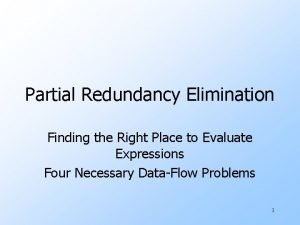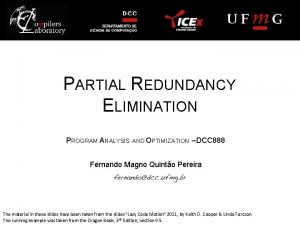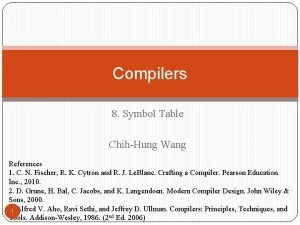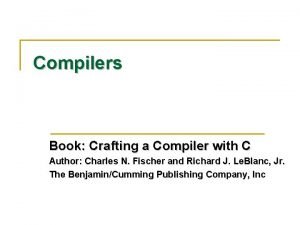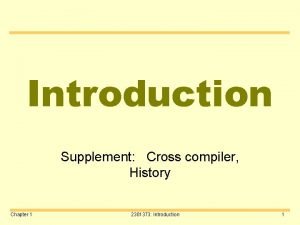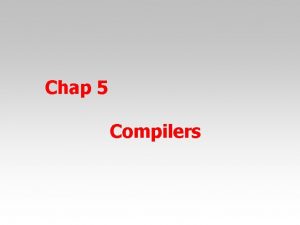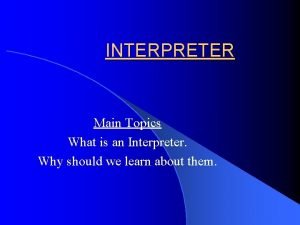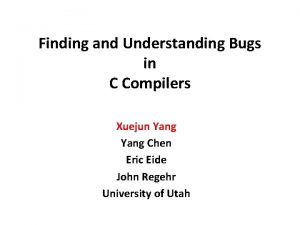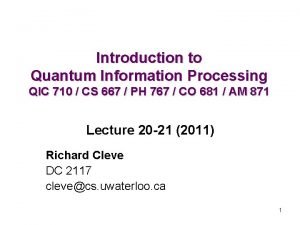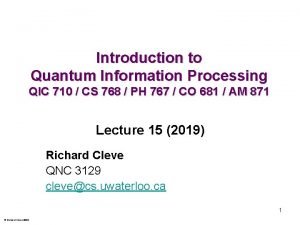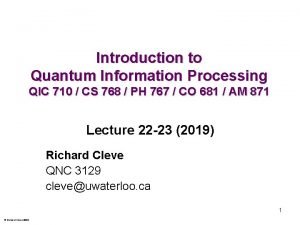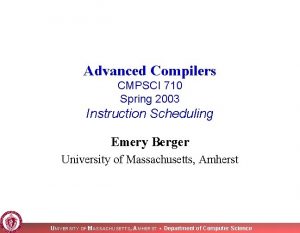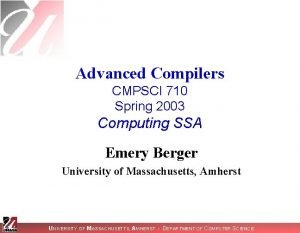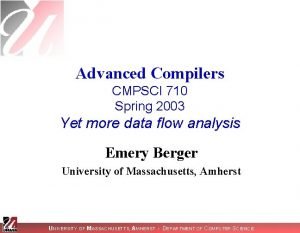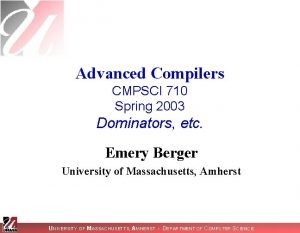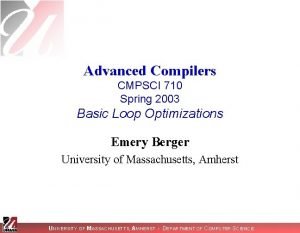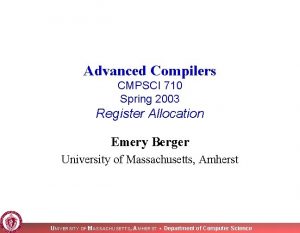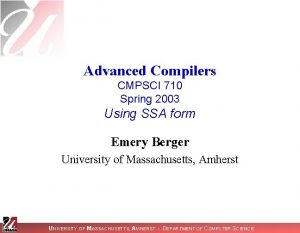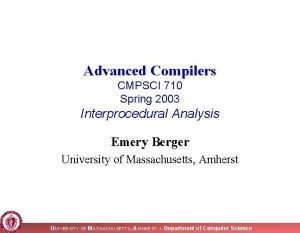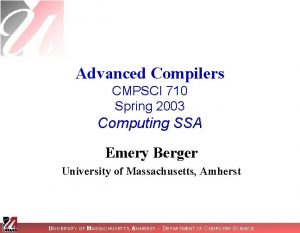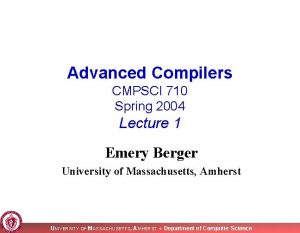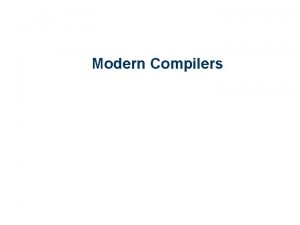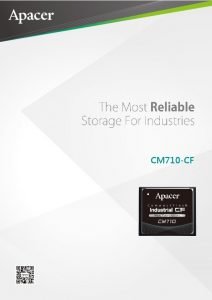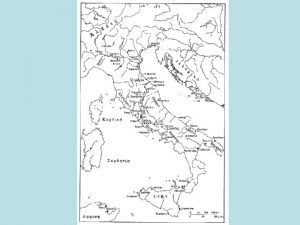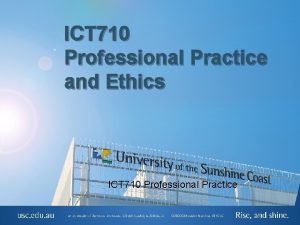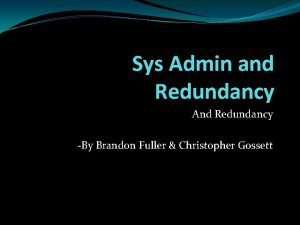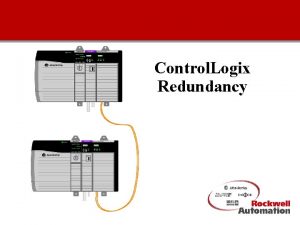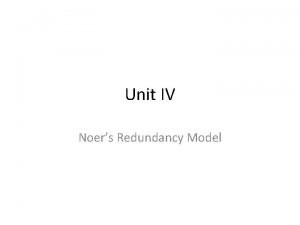Advanced Compilers CMPSCI 710 Spring 2003 Partial Redundancy








![PRE Dataflow Equations n First formulation [Morel & Renvoise 79] bidirectional dataflow analysis n PRE Dataflow Equations n First formulation [Morel & Renvoise 79] bidirectional dataflow analysis n](https://slidetodoc.com/presentation_image_h2/52379e21639d10971ea9eca7ed20fc99/image-9.jpg)












- Slides: 21

Advanced Compilers CMPSCI 710 Spring 2003 Partial Redundancy Elimination Emery Berger University of Massachusetts, Amherst UNIVERSITY OF MASSACHUSETTS, AMHERST • Department of Computer Science

Topics n Last time n n Common subexpression elimination n Value numbering n Global CSE This time n Partial redundancy elimination UNIVERSITY OF MASSACHUSETTS, AMHERST • Department of Computer Science 2

Partial Redundancy n Partial redundancy: n n Expression computed more than once on some path through control-flow graph Partial-redundancy elimination (PRE): n Minimizes partial redundancies n Ø n Inserts and deletes computations (adds temps) Each path contains no more (usually fewer) occurrences of any computation than before Dominates global CSE & loop-invariant code motion UNIVERSITY OF MASSACHUSETTS, AMHERST • Department of Computer Science 3

PRE Example UNIVERSITY OF MASSACHUSETTS, AMHERST • Department of Computer Science 4

PRE: Problem n Critical edge prevents redundancy elimination n n Connects node with two or more successors to one with two or more predecessors Why is it a problem? UNIVERSITY OF MASSACHUSETTS, AMHERST • Department of Computer Science 5

PRE: Solution n Split critical edges! n n Insert empty basic blocks Allows PRE to continue UNIVERSITY OF MASSACHUSETTS, AMHERST • Department of Computer Science 6

Big Example: Critical Edges UNIVERSITY OF MASSACHUSETTS, AMHERST • Department of Computer Science 7

Big Example: Critical Edges Removed UNIVERSITY OF MASSACHUSETTS, AMHERST • Department of Computer Science 8
![PRE Dataflow Equations n First formulation Morel Renvoise 79 bidirectional dataflow analysis n PRE Dataflow Equations n First formulation [Morel & Renvoise 79] bidirectional dataflow analysis n](https://slidetodoc.com/presentation_image_h2/52379e21639d10971ea9eca7ed20fc99/image-9.jpg)
PRE Dataflow Equations n First formulation [Morel & Renvoise 79] bidirectional dataflow analysis n n Ugly This version [Knoop et al. 92] n Based on “lazy code motion” n n Places computations as late as possible Same reductions as classic algorithm Minimizes register pressure Most complex dataflow problem we’ve ever seen… UNIVERSITY OF MASSACHUSETTS, AMHERST • Department of Computer Science 9

Step 1: Local Transparency n Expression’s value is locally transparent in a basic block if n n n No assignments to variables that occur in expression Set of locally transparent expressions: TRANSloc(i) Note: Ignore expressions in branches UNIVERSITY OF MASSACHUSETTS, AMHERST • Department of Computer Science 10

Local Transparency Trans. Loc – no assignments to variables in expression UNIVERSITY OF MASSACHUSETTS, AMHERST • Department of Computer Science 11

Step 2: Locally Anticipatable n Expression is locally anticipatable in basic block if n n There is computation of expression in block Moving to beginning of block has no effect n n No uses of expression nor assignments of variable in block ahead of computation Set of locally anticipatable expressions: ANTloc(i) UNIVERSITY OF MASSACHUSETTS, AMHERST • Department of Computer Science 12

Locally Anticipatable ANTloc – computes expr, can move to front UNIVERSITY OF MASSACHUSETTS, AMHERST • Department of Computer Science 13

Step 3: Globally Anticipatable n Expression’s value globally anticipatable on entry to basic block if n n n Every path from that point includes computation of expression Expression yields same value all along path Set of globally anticipatable expressions: ANTin(i) UNIVERSITY OF MASSACHUSETTS, AMHERST • Department of Computer Science 14

Globally Anticipatable Expressions: Dataflow Equations n n ANTout(exit) = ANTin(i) = ANTloc(i) [ (TRANSloc(i) Å ANTout(i)) ANTout(i) = Åj 2 Succ(i) ANTin(j) What’s the analysis direction? UNIVERSITY OF MASSACHUSETTS, AMHERST • Department of Computer Science 15

Globally Anticipatable ANTout(exit) = ANTin(i) = ANTloc(i) [ (TRANSloc(i) Å ANTout(i)) ANTout(i) = Åj 2 Succ(i) ANTin(j) UNIVERSITY OF MASSACHUSETTS, AMHERST • Department of Computer Science 16

Step 4: Earliest Expressions n Expression is earliest at entrance to block if n No block from entry to block both: n n n Evaluates expression and Produces same value as at entrance to block Defined in terms of local transparency and globally anticipatable expressions n n n EARLin(i) = [j 2 Pred(i) EARLout(j) EARLout(i) = inv(TRANSloc(i)) [ (inv(ANTin(i)) Å EARLin(i)) Initialize EARLin(entry) = Uexp UNIVERSITY OF MASSACHUSETTS, AMHERST • Department of Computer Science 17

Early Expressions EARLin(i) = [j 2 Pred(i) EARLout(j) EARLout(i) = inv(TRANSloc(i)) [ (inv(ANTin(i) Å EARLin(i)) UNIVERSITY OF MASSACHUSETTS, AMHERST • Department of Computer Science 18

PRE Transformation n We’ll cut to the chase: n Latest, Isolated expressions n n Use earliest, globally anticipatable OPT(i) = latest but not isolated = LATEin(i) Å inv(ISOLout(i)) REDN(i) = used but not optimal = ANTloc(i) Å inv(LATEin(i) [ ISOLout(i)) Insert fresh temporaries for OPT expressions, replace uses in REDN UNIVERSITY OF MASSACHUSETTS, AMHERST • Department of Computer Science 19

OPT, REDN, PRE OPT(B 1) = a+1 OPT(B 2, B 3 a) = x*y REDN(B 1) = a+1 REDN(B 2, B 4, B 7) = x*y UNIVERSITY OF MASSACHUSETTS, AMHERST • Department of Computer Science 20

Conclusion n PRE n n Subsumes global CSE & loop-invariant code motion Complex (but unidirectional) dataflow analysis problem Can only reduce number of computations and register pressure Next time n Register allocation: ACDI ch. 16, pp. 481 -524 UNIVERSITY OF MASSACHUSETTS, AMHERST • Department of Computer Science 21
 Spring, summer, fall, winter... and spring (2003)
Spring, summer, fall, winter... and spring (2003) Bhavish
Bhavish Partial redundancy elimination
Partial redundancy elimination Inanticipable
Inanticipable Yacc symbol table
Yacc symbol table Binarymove c++
Binarymove c++ Compilers book
Compilers book Introduction to compiler and interpreter
Introduction to compiler and interpreter Cross compilers
Cross compilers Basic compiler functions in system software
Basic compiler functions in system software Cs 421 programming languages and compilers
Cs 421 programming languages and compilers Pros and cons of compilers and interpreters
Pros and cons of compilers and interpreters Depict structure of front end of a compiler
Depict structure of front end of a compiler Elsa gunter uiuc
Elsa gunter uiuc Finding and understanding bugs in c compilers
Finding and understanding bugs in c compilers Summer spring winter fall
Summer spring winter fall Qic 710
Qic 710 Qic 710
Qic 710 Euperlan pk 3000 am
Euperlan pk 3000 am A gas has a pressure of 710 kpa at 227
A gas has a pressure of 710 kpa at 227 Qic710
Qic710 Din vde 0100 teil 710
Din vde 0100 teil 710


